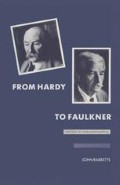Abstract
It seems useful at this point to attempt to draw together some of the correlations between Hardy’s and Faulkner’s lives and work which have emerged from previous chapters, thereby approaching some brief discussion of formal achievement through a reacquaintance with those factors which inspired their content.
an endeavour to give shape and coherence to a series of seemings, or personal impressions
(‘Preface’ to Jude)
the truth is what they saw though nobody saw the truth intact
(Faulkner in the University, pp. 273–4)
Access this chapter
Tax calculation will be finalised at checkout
Purchases are for personal use only
Preview
Unable to display preview. Download preview PDF.
Notes
H. J. Massingham, Men of Earth (London, 1943) pp. 155–6.
‘In the Old Testament (2 Sam. 13), Absalom, one of David’s sons, kills his brother Amron for raping their sister Tamar’ (see John T. Irwin, Doubling and Incest/Repetition and Revenge: A Speculative Reading of Faulkner (Baltimore, Md., 1975) p. 25.
Critical descriptions of each novel help to show the two novels’ common high literary ambitions and ancestry: e.g. Millgate remarks that ‘Hardy establishes Henchard in all his particularity of time, place, and class, and then surrounds him with patterns of classical, biblical, and Shakespearian imagery… susceptible to analogies with Oedipus, Samuel, and Lear… he emerges as a figure on the grand scale of a Heathcliff or Captain Ahab’ (Michael Millgate Thomas Hardy: A Biography (Oxford, 1982) p. 253).
Cf. Minter’s comments upon Absalom’s ‘allusional density: its evocations of stories from the Old Testament; from Greek drama and myth; from Cervantes, Shakespeare, Melville, and Conrad’ (David Minter, William Faulkner: His Life and Work (Baltimore, Md., 1980) p. 153).
Wittenberg similarly suggests that ‘Sutpen also had vital personal meaning for Faulkner as a portrait of his own great-grandfather, the Old Colonel, and as one of his last statements about the dashing figure who had psychologically dominated his formative years’ (Judith Bryant Wittenberg, Faulkner: The Transfiguration of Biography (Lincoln, Nebr., 1979) p. 151).
He sees as a participant who is also an observer; this is the source of the strain… [causing] spurts of bitterness and nostalgia’, which evokes Quentin’s position exactly (see Raymond Williams, The Country and the City (London, 1973) pp. 249–50).
But Quentin will. Faulkner was a reader of Conrad from an early age (see Joseph L. Blotner, Faulkner: A Biography (New York, 1974) pp. 110, 160).
One wonders if the equally striking similarity of name is a mere coincidence! See David Jarrett, ‘Eustacia Vye and Eula Varner, Olympians: The Worlds of Thomas Hardy and William Faulkner’, in Novel: A Forum on Fiction, vol. 6 (Winter 1973).
I must acknowledge that my attention was drawn to this memorable image by John Bayley’s discussion of Hardy’s style: see An Essay on Hardy (Cambridge, 1978) p. 18.
Alfred Kazin, ‘Faulkner’s Vision of Human Integrity’, The Harvard Advocate, vol. 155 (November 1951) pp. 8–9, 28–33.
Michael Millgate, The Achievement of William Faulkner (London, 1966) p. 189.
Author information
Authors and Affiliations
Copyright information
© 1989 John Rabbetts
About this chapter
Cite this chapter
Rabbetts, J. (1989). ‘A series of seemings’: the Marriage of Form and Content. In: From Hardy to Faulkner. Palgrave Macmillan, London. https://doi.org/10.1007/978-1-349-19765-1_5
Download citation
DOI: https://doi.org/10.1007/978-1-349-19765-1_5
Publisher Name: Palgrave Macmillan, London
Print ISBN: 978-1-349-19767-5
Online ISBN: 978-1-349-19765-1
eBook Packages: Palgrave Literature & Performing Arts CollectionLiterature, Cultural and Media Studies (R0)

